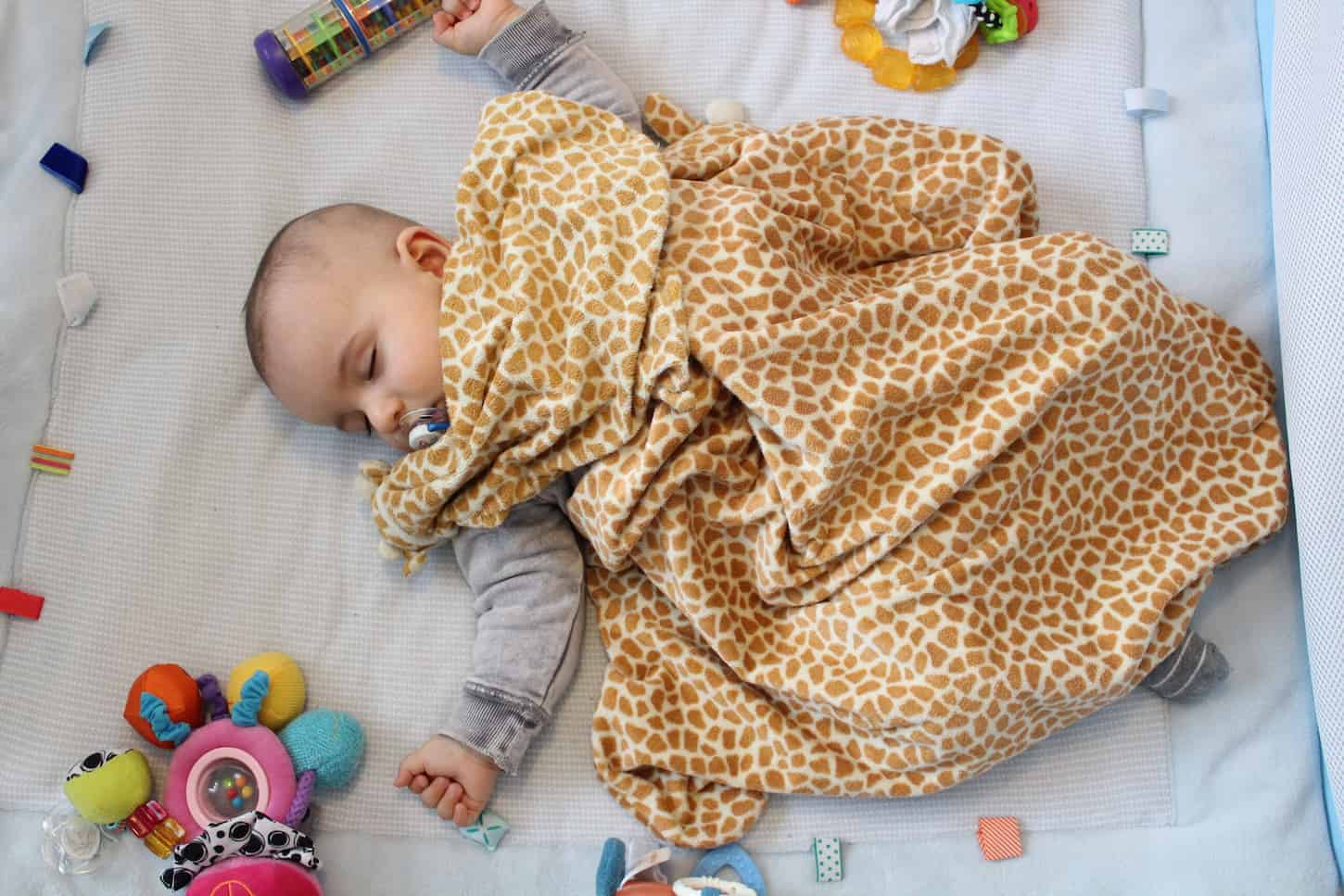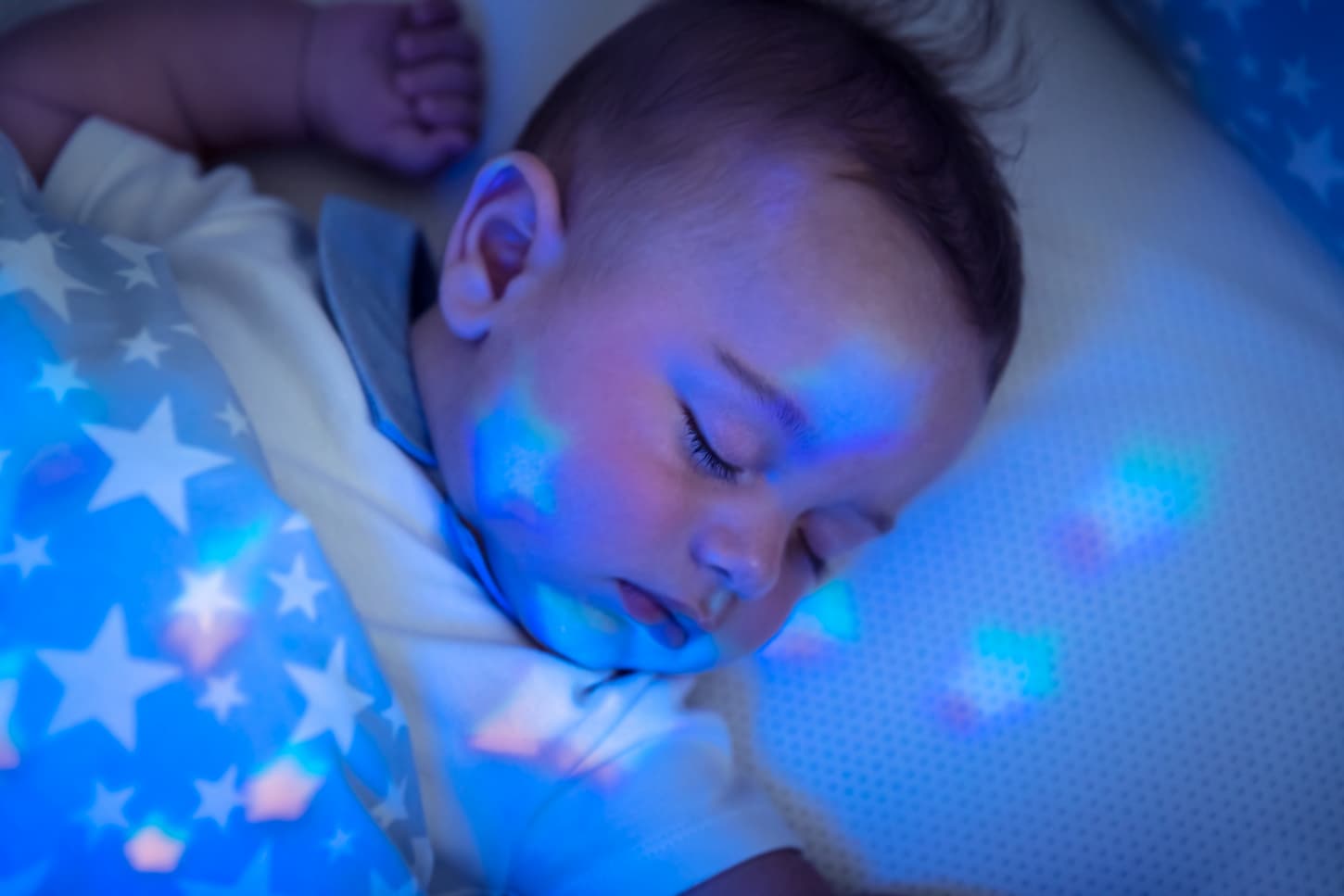A commonly-asked question about sleep regressions is this: are they a real thing, or are they a made-up thing? Because what I experienced sure feels real. So let’s ask (and answer) our question: are sleep regressions real?
While sleep regression is not a diagnosable condition or a real medical term, it incorporates aspects of two actual conditions: sleep disturbances and behavioral regressions into a new, evolving term that’s becoming more widely used in everyday speech.
Let’s take a deeper dive into what the evidence and history have to say about the reality of sleep disturbances and the evolving term of sleep regressions.

Real or Fake? Sleep Regressions at a Glance
Looking through the scientific literature, no conclusive, universally accepted evidence proves whether or not all sleep regressions are real. There are also zero mentions of sleep regressions within the DSM-V, billable medical codes, and nursing diagnoses.
However, some studies correlate developmental transitions and sleep disturbances. And developmental transitions, regressions, and sleep disturbances are very much real and diagnosable conditions.
In other words, within the medical field sleep regressions aren’t seen as fake or real. It’s seen as a poorly combined terminology between “sleep disturbances” and “regressions,” both of which are accepted terms that are studied in depth.
The term “sleep regression” is still used so much in the general vernacular and vocabulary, though, that it’s worth using. Just keep in mind that it’s a combined term – that incorporates both sleep disturbances and normal behavioral regressions associated with stress.
Sleep regressions (via sleep disturbances) are still being studied, followed, and researched. They’re just not diagnosable at this time.
So let’s look at the studies that have been used to build up the history of sleep regressions.
If you’re wondering how exactly sleep regressions and disturbances differ, make sure to read my article on that right here.
The Real History of Sleep Regression Studies
The studies that led to the commonly-accepted terminology of “sleep regressions” started with astute observation of primates.
There’s a study on primates in 1974 that deals with what the lead study termed “regressive periods” – but those had more to do with nursing rates and nipple contact than sleep. (See Citation 1)
In 1992, Dr. Plooij and Dr. van de Rijt took the above research and took it a step further – they looked at 15 mother-infant pairs to look for periods of disorganization and regression in humans. They published a peer-reviewed article that proposed 10 periods of difficulty. (Feel free to read that abstract over at the Journal of Reproductive and Infant Psychology or see citation 2)
That same year, the doctors published a book that turned these 10 periods into leaps – and used them as guidelines to give parents an idea as to when to expect difficult behaviors as well as what to do about them.
That book was a direct-to-the-public release – and wasn’t peer-reviewed. It was, however, a huge success that helped countless parents worldwide. If you’d like to get your copy of that book, it’s available on Amazon.
A follow-up study tried to replicate those results in 1998 with 4 more mother-infant pairs that failed to support the 10-period pattern. (Source: read that study over at the American Psychological Association or see citation 3)
Another attempt to show the validity of sleep regressions was done by Dr. Mindell of Children’s Hospital in Philadelphia in 2018.
The data clearly indicates that there’s no specific age at which all of a sudden you see a shift in sleep.
Dr. Mindell, NY Times Parenting
In other words, over the last handful of decades, researchers have begun to realize that there are normal periods of disruption and disorganization in development that may lead to a temporary behavioral regression – both in our primate cousins and in humans.
Researchers refer to these periods of disturbed sleep as sleep disturbances, not sleep regressions. In the public sphere, though, many people use the term “sleep regression” in place of “sleep disturbance.” It’s not 100% correct, but it is used nonetheless.
Nor do researchers have a conclusive list of all of the existing or possible sleep regressions. In other words, scientists are still figuring out all of the details about the overall picture.
So let’s look at some more recent studies – that offer better, more conclusive results on a smaller and more specific scale.
Scientific Studies that Show the Reality of Sleep Disturbances (and Regressions)
While there may not be a conclusive study that shows every single sleep regression, there are individual studies that give great, conclusive results. And, they’re done with better, more reliable (and repeatable!) methods.
In a 2015 study, researchers concluded that learning to crawl did indeed cause sleep disruption. They wrote:
… emerging motor skills may involve periods of disrupted sleep, and point to the moderating effect of age.
Source: Sleep as a Mirror of Developmental Transitions in Infancy: The Case of Crawling, Citation 4
In other words, there’s a normal sleep disturbance when a baby learns to crawl – and it takes time for the child to learn to overcome that disturbance.
Another study in 2016 found similar results when a baby learns to stand.
It was found that early achievers of PTS (pull-to-stand by 8 months), the milestone was time-linked to a period of disrupted sleep.
Source: Sleep Disruption and Motor Development: Does Pulling-to-Stand Impact Sleep-Wake Regulation? (Citation 5)
Other studies (and common sense) readily acknowledge that it’s very common for children to experience noticeable sleep disturbances at these times:
- During or after a vacation
- When there’s been a time change
- After a large life change, like parents separating or divorcing
During these stressful periods that affect sleep, it’s also common for children to experience a behavioral regression. If you’d like to read the information on these topics, they’re available at HealthyChildren.org: vacation, separation/divorce, and behavioral regressions.
So while sleep regression isn’t a diagnosable condition, sleep disturbances are being shown to be a reality, time and time again throughout published, peer-reviewed scientific studies. Combined with a possible concurrent behavioral regression, it’s almost no wonder that the terms have been combined into a “sleep regression” within the public vocabulary.
There just isn’t a specific, conclusively proven timeline that shows when every sleep regression will happen. And scientists refer to them as sleep disturbances, not regressions.
Getting that kind of a specific timeline won’t happen for a while (if at all) because of a few important facts.
Reasons why a specific sleep regression timeline won’t happen soon include:
- Studies rely heavily on self-reports or surveys
- Every child develops at their own pace
- Children’s development is affected by countless factors – each of which has to be accounted for
- Studies rely on large quantities of reliable data
- Sleep deprivation affects memory – and new parents are frequently sleep-deprived
This is being shown in studies and literature reviews, too. In one comparison between 40 full-term infants and 24 premature babies, scientists concluded this about their sleep patterns and disturbances:
The premature group is more variable from one age to the next, even though both groups demonstrate significant individual stability of some sleep-wake variables over the first year of life.
Source: National Center for Biotechnology Information, US National Library of Medicine (Citation 6)
All of this being said, there is an overwhelming amount of anecdotal evidence that does support the reality and validity of sleep regressions.
Anecdotal Evidence of the Reality of Sleep Regressions
Anecdotal evidence of sleep disturbances (and sleep regressions) is everywhere. Think of the last time that someone (perhaps yourself) recognized a sleep issue and shared that story with you. Those stories are anecdotal evidence.
Thus, anecdotal evidence of sleep regressions is everywhere.
Here’s my anecdotal evidence of the awful 11-month-old sleep regression tied into my research. In my own experience, that and the 4-month-old sleep regression are the two worst.
Conclusion: Sleep Regressions Are Sleep Disturbances Plus Regressions
After looking at all of the real history and studies about sleep disturbances, it’s easy to see how the term “sleep regression” came into being. It’s probably a combination of the terms “sleep disturbance” and behavioral “regression” – into a new, evolving term: “sleep regression.”
It’s just not a term that’s used in any of the scientific literature. However, that doesn’t mean it’s not real. Instead, it just means that researchers and everyday people are using slightly different terminology.
And that’s okay because that’s how our language works – by incorporating various words and creating new vocabulary words to use. That’s why it’s important to know that sleep regressions are a real thing – albeit one that developed from different terms (sleep disturbances and behavioral regressions).

Sources and Citations
- Horwich, Robert. (1974). Regressive periods in primate behavioral development concerning other mammals. Primates. 15. 141-149. 10.1007/BF01742277.
- PhD, Hedwig & Plooij, Frans. (1992). Infantile regressions: Disorganization and the onset of transition periods. Journal of Reproductive and Infant Psychology. 10. 129-149. 10.1080/02646839208403946.
- Weerth, Carolina & van Geert, Paul. (1998). Emotional instability is an indicator of strictly timed infantile developmental transitions. British Journal of Developmental Psychology. 16. 10.1111/j.2044-835X.1998.tb00748.x.
- Scher, Anat & Cohen, Dina. (2015). V. sleep as a mirror of developmental transitions in infancy: The case of crawling. Monographs of the Society for Research in Child Development. 80. 70-88. 10.1111/mono.12145.
- Atun-Einy, Osnat & Scher, Anat. (2015). Sleep disruption and motor development: Does pulling-to-stand impacts sleep-wake regulation?. Infant behavior & development. 42. 36-44. 10.1016/j.infbeh.2015.11.003.
- Anders, Thomas & MA, Keener. (1985). Developmental Course of Nighttime Sleep-Wake Patterns in Full-Term and Premature Infants During the First Year of Life. I.. Sleep. 8. 173-92. 10.1093/sleep/8.3.173.
Related Questions
At What Ages Do Sleep Regressions Commonly Happen? Noticeable sleep disturbances (or regressions) with big developmental leaps – or at about 4 months, 8 months, 11 months, and 15 months. For exact timing, please see my article on when sleep regressions happen.
Do All Babies Go Through The 4-Month Sleep Regression? Not every child will experience a noticeable or lasting regression with each developmental leap, depending on a host of circumstances.
How Long Do Sleep Regressions Last? Sleep regressions may last anywhere from a few days up to six weeks or longer. To get a better idea of how long it may last for you, make sure you read my article on how long sleep regressions last.